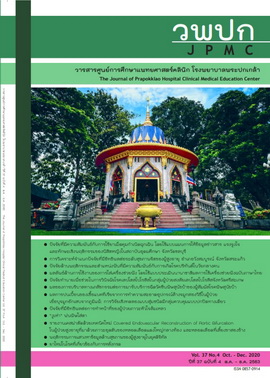The Outcome of Pharmaceutical Care on Rabies Vaccination of Rabies Exposed Persons
Main Article Content
Abstract
Background: Rabies is a contagious disease, which can be transmitted from animals to humans and is a public health problem. Pharmaceutical care together with the required medical guidance including information about the disease, treatment, number of vaccinations, and advice about the use of drugs would influence patients to receive their vaccination appropriately.
Objective: To study the outcome of pharmaceutical care on the rabies vaccination of rabies exposed persons.
Materials and methods: The study was a quasi-experimental research comparing the outcome between pre and post-intervention from different individuals. Data were collected from 100 rabies exposed patients at the Surgery Department and Emergency Room in Prapokklao Hospital, Chanthaburi Province, Thailand during February-April 2020. The research instruments consisted of pharmaceutical care and a designed data recording form. Descriptive statistics and a Chi-square test were applied for analyzing the data.
Results: According to the survey, most of the test subjects were female, the average age of the pre-intervention group was 42.0 (SD = 21.6), and the average age of the post-intervention group was 37.1 (SD = 22.4). The gender and average age of the test subjects did not show any difference (p > 0.05). Both groups were mostly bitten, and the number of patients of each type of disease exposure characteristics was not different (p > 0.05). The disease carrier type were mostly dogs and cats. The number of patients classified by the carrier type and the carrier past records did not show any difference (p > 0.05). The number of patients that were prescribed with antiseptic, immunoglobulin, and antibiotics in both groups were not dissimilar (p > 0.05). Furthermore, the results of the post-intervention group happened to be more thorough and received the vaccination on schedule.
Conclusion: According to the survey, the post-intervention patients adhered more to the medication process, as 99.0% of the patients in this group received the medication thoroughly and on schedule. The dosage of each immunoglobulin was reduced as well as the number of prescribed patients. In conclusion, the pharmaceutical care displayed more attention to detail and had scheduled medical appointments.
Article Details
References
OngwandeeS,Choomkasien P, Chutiwongse N, Tangcharoensathien V. Cost-benefit of Rabies Control under a Hypothetical Intensified Dog Control Program in Thailand. Journal of Health Science 2003;12,937-48.
Ministry of Public Health, Department of Disease Control, Bureau of Epidemiology. Annual Epidemiological Surveillance Report 2017[Internet].[cited 2019 Sep 20]. Available from: https://apps.boe.moph.go.th/boeeng/download/AESR-6112-24.pdf
Sagarasearanee O, Hinjoy S, Chuxnum T, Chantean T, Smithsuwan P, Jorhor N, et al. Survey of knowledge, attitude and practice initiated by an investigation of a human rabies death in Chantaburi Province, Thailand 2015. OSIR 2017;10(3):1-8.
Ministry of Public Health. Rabies Clinical practice guidelines and frequency asked questions. 5th ed. Nontaburi: Bureau of General Communicable Diseases, Department of Disease Control; 2016.
Thai Red Cross Society. Rabies clinical practice guidelines 2018, Queen Saovabha Memorial Institute, Thai Red Cross Society, and frequently asked questions. Bangkok: Rabies Immunization Clinic, Queen Saovabha Memorial Institute; 2018.
Sriboonruang S, Tantawichien T. Rabies prevention and Post-Exposure Rabies Treatment [Internet]. [cited 2019Sep20]. Available from: https://www.saovabha.com/download/vichargarn_rabies.pdf
Debavalya U, Moolasarn S, Orossarum J, Samangsri K, Yenwijitsopa A, Jaipen P. The impacts of home care pharmacy service in diabetic patients. Thai Journal of Hospital Pharmacy 2008;18:39-51.
Nakdee P, Kosuma P. Management of the rabies post-exposure prophylaxis program according to the Thai clinical practice guideline in rabies: a study in community hospital and Tambon Health Promoting Hospital. IJPS, 2019;15(2):81-97.
Bernard R. Fundamentals of biostatistics. 5th ed. California: Duxbery press; 2000.
Fleiss J L, Levin B, Paik MC. Statistical methods for rates and proportions. 3rd ed. New Jersey: .John Wiley&Sons; 2003
Phummangkun C. Philosophy of pharmaceutical care. In: Phummangkun C, Tanyasansuk K, editor. Pharmacotherapy. 2nd ed. Bangkok: New Thai Mitr Printing 1996 Limited; 2004. P. 1-19.
Visai R, Sripanyavit U, Aremit P, Soontornpat C, Verayingyong N. The effectiveness pharmaceutical care at medical wards. Thai Journal of Hospital Pharmacy 2000;10:126- 32.
Ellis R, Ellis C. Dog and cat bites. Am Fam Physician 2014;90:239-43.
Stevens DL, Bisno AL, Chambers HF, Dellinger EP, Goldstein EJC, Gorbach SL, et al. Practice guidelines for the diagnosis and management of skin and soft tissue infections:2014 update by the infectious diseases society of America.Clin Infect Dis 2014;59:147-59.
Bongjaporn N,Khantikul N, Arunothong S. Relationship between age groups and self-care behaviors of suspected rabies exposed in Northern of Thailand. ODPC9J 2020; 26(1),36-46.
Worathitianan B, Chockchalermwong S, Reongkhumklan S. Economic impact of revised rabies immunoglobulin administration protocol 2018 in the emergency department, NakhonPathom Hospital. Disease Control Journal 2019;45:293-304.
Galnade S, Prasertchai A, Chankong W. Factors relating vaccine acceptance among post rabies exposure clients in Kantharom District, Si Sa Ket Province. Journal of Science and Technology, Ubon Ratchathani University 2019; 21(2): 34-47.
Tee-ngam T, Suggaravetsiri P. Factors associated with incomplete vaccination among rabies exposures at Yangsisurat District in Mahasarakham Province. KKU Journal for Public Health Research 2020;13(1):33-40.

